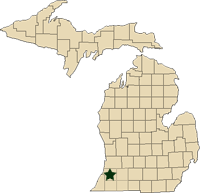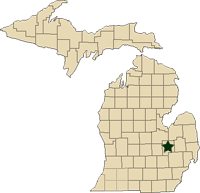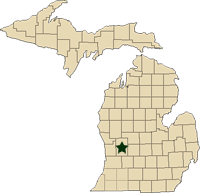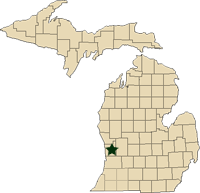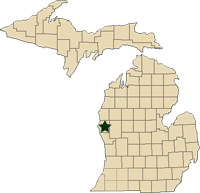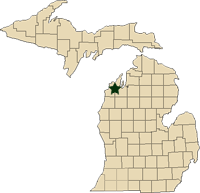Regional reports on Michigan fruit – June 7, 2011
MSU Extension educators’ pest and fruit updates for Michigan
This week’s regional reports:
- Southwest Michigan - Mark Longstroth, Bill Shane, and Diane Brown-Rytlewski
- Southeast Michigan - Bob Tritten
- Grand Rapids Area Tree Fruit - Amy Irish Brown and Phil Schwallier
- Grand Rapids Area Small Fruit – Carlos García-Salazar
- West Central Michigan - Mira Danilovich
- Northwest Michigan - Nikki Rothwell, Duke Elsner, and Erin Lizotte
Southwest Michigan – Mark Longstroth, Bill Shane, and Diane Brown-Rytlewski, Michigan State University Extension
|
Last week was warm and dry with highs in the 80s and upper 70s. There were no significant rains. The increased heat and fully developed leaf canopies increased plant water use. While heavier soils still have good moisture, sandy soils are beginning to dry out. Soil temperatures are in the mid-60s. We are less than a week behind average for fruit development. Check for the closest weather station at Enviro-weather.
| Southwest Michigan Growing Degree Day Totals from March 1 through June 5 | |||
| Location | GDD 42 | GDD 45 | GDD 50 |
| Bainbridge | 885 | 720 | 490 |
| Trevor Nichols: | 787 | 636 | 426 |
Tree fruit
Plum curculio egglaying has been heavy in the last week and scars are easy to find. Oriental fruit moth was biofixed on May 8 and there was a second peak in the flight in last week’s heat. Rose chafer has emerged and should be feeding for the next two weeks. San Jose scale males are being trapped and we expect crawlers in two to three weeks, depending on the temperature.
Apricots are 1.25 inches in diameter. There seems to be a good crop out there and most of the fruit I have seen looks clean.
Peaches are 18 to 20 mm in diameter. Controls for tarnished plant bug and plum curculio should be on to protect the fruit. First generation oriental fruit moth generally attack tender shoot tips, but may attack fruit. With the strong flight last week, you can expect more injury to shoot tips.
Sweet cherries are 14 mm in diameter. Sweet cherries are susceptible to brown rot infection in warmer rains. Sweet cherries are also susceptible to cherry leaf spot.
Tart cherries are 12 mm in diameter and a heavy drop is apparent on some trees with a heavy crop load and not enough leaves. The crop appears light. Cherry leaf spot symptoms have been found in some orchards. Fungicide resistance may be the problem if your orchard has a lot of cherry leaf spot. Plum curculio egglaying should end this week.
Plums are 16 mm in diameter and the crop is light. Plum curculio pressure has been heavy. Growers should maintain black knot controls until shoot growth ends.
Apples are 10 to 18 mm in diameter. In most orchards, a heavy drop and early thinning sprays resulted in a very manageable fruit set. Growers who have not applied thinners can apply them this week. Apple thinning will be fair to poor this week. We are at the end of the apple thinning window. Growers should be aggressive if they want to drastically reduce the crop.
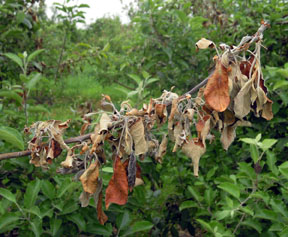
Fire blight symptoms in apple in June 2011. Photo credit: Mark Longstroth, MSUE.
Fire blight blossom blight symptoms are easy to find in some orchards. Wilting shoots and ooze indicate the disease is spreading in the tree. The lush, succulent growth on trees now is very susceptible to the interior spread of the bacteria.Apogee application is still an option to slow fire blight spread in orchards with active infections and susceptible varieties. Apple scab symptoms on leaves and fruit are generally scarce in spite of the heavy disease pressure this year. We are at the end of apple scab primary ascospore maturity, but probably not all the spores have been discharged. We need one more rain to release the final batch of spores. Growers still need to scout their orchards to determine if they have scab leaf lesions. If you have active leaf lesions, you need fungicide coverage to protect against secondary scab infection. Powdery mildew is a concern on susceptible varieties.
Insect activity is now the primary concern in apples. The fruit are vulnerable and warmer temperatures have increased insect activity. We are catching codling moth in good numbers and codling moth biofix for the region ranges from June 1-3. We are 90 to 110 GDD Base 50 after biofix. Oriental fruit moth larvae are expected to start attacking apple fruit soon. Plum curculio egglaying is still ongoing. Tarnished plant bug may be feeding on the fruit. Aphids and leafrollersobliquebanded leafroller were reported in southwest Michigan last week, but not a consistent catch to determine biofix. can be found in many orchards. The first catches of obliquebanded leafroller were reported in southwest Michigan last week, but not a consistent catch to determine biofix.
Pear fruit are 18 mm in diameter. The pear crop generally looks light. Pear psylla adults and nymphs can be found.
Small fruit
Grape shoots are 16 to 24 inches long and the individual flower buds are separated in the cluster. There is the potential for a very heavy crop. Bloom could begin any day. Fredonia bloom has begun. Bloom in wild grapes began last week. Seventy-five percent bloom is the biofix used for grape berry moth sprays for the second and third generation. We set biofix for second generation grape berry moth in Berrien County at the beginning of last week (May 30-31) and set biofix in Van Buren County at the middle of last week (June 1-2). Trap catches of first generation grape berry moth continue to increase, but there is really no need to apply insecticides for the first generation. 810 GDD Base 47 after biofix marks the beginning of egglaying for the second generation and is the time to apply controls for grape berry moth.
We have also begun to see rose chafer, grape leafhopper and potato leafhopper in low numbers. There is no need to apply insecticides to control these pests until after bloom. Bloom sprays should focus on disease control. Phomopsis is symptoms are common. Growers should continue to apply fungicides to protect developing clusters. Rachis infections occur during the spring and early summer and can cause serious damage. Fruit infections at and soon after bloom can result in fruit losses up to 30 percent. Both types of infections remain latent until near harvest. The fungus does not sporulate, or produce spores on this season’s infections. This means that as spores from old lesions are depleted, there is no more inoculum to cause new infections.
Black rot and downy mildew symptoms have not been observed at the sites we are monitoring, but we have had several infection periods favorable for black rot leaf infections in the Southwest, according to the black rot model available on Enviro-weather and favorable conditions for downy mildew.
There is a grape IPM meeting at Cronenwett Farms, 70121 28th Street, located East of Lawton, on June 8 from noon to 3:00 PM. Growers should RSVP for the meeting by calling the Berrien County MSU Extension office at 269-944-4126. The meeting charge is $15 if you register in advance, and $20 day of meeting, and includes lunch. Thinning will be important this year because there are numerous flower clusters developing and it will be important to manage crop load. The meeting will focus on crop load adjustment and include updates on current insect and disease issues.
Blueberries have small, green fruit and shoot growth has stopped in most fields. The crop is very variable with many fields having a light crop. While some varieties are affected more than others, two fields of the same variety close together may have very different crop loads. Growers need to protect against anthracnose fruit rot and fruitworms. Both cranberry fruitworm and cherry fruitworm were biofixed in late May or early June and controls should be on the fruit.
There is a blueberry IPM meeting at True Blue Farms, located south of Grand Junction, on Thursday, June 9 from 6:00 to 8:00 PM. There will be reviews of post-bloom and preharvest pest controls and a discussion of irrigation. A charge of $10 for dinner will be collected at the door. Please RSVP to Mark Longstroth or the Van Buren County MSU Extension office in Paw Paw at 269-657-8213.
Strawberry fruit are growing rapidly and the largest fruit are coloring. Fruit from hoophouses and early varieties in Berrien County is being harvested. Tarnished plant bug feeding has deformed fruit in some fields. Leaf spot diseases are common. Leaf burn from copper sprays is showing up.
In brambles, bloom of many summer bearing raspberries is ending. Bloom in blackberries continues. Growers should be scouting for leafrollers, leaf hoppers and rose chafer. Fungicides to reduce fruit rots and cane diseases are worthwhile. Primocanes in fall bearing raspberries are almost two feet tall.
Southeast Michigan – Bob Tritten, Michigan State University Extension
|
Weather
We have had a hot, windy and dry week over the region. Lighter soils are drying out quickly. It is unusual to see the soil moisture situation turn around so fast, seeing that we have had a very wet spring throughout the region. At several farms I have seen evidence that newly planted tree and small fruits are starting to show signs of drought stress, and many farms are considering irrigating this week if we do not receive rainfall. Again, it is hard to believe that we have turned the corner so quickly from wet soils to dry soils.
Our season is still running far behind normal for some fruit crops and others seem to be picking up speed in terms of when fruit will be harvested. It appears to me that strawberry harvest will be about seven to nine days behind normal at most farms. I believe that sweet cherries will be harvested on or about their normal date, which for many growers is around July 4.
Many tree fruit growers are trying desperately to catch up on their mowing operations and other field work. Peaches are being thinned and newly planted strawberries are being cultivated.
| Southeast Michigan Growing Degree Day Totals for March 1 to June 6 | |||
| Location | GDD42 | GDD45 | GDD50 |
| Commerce (Oakland) | 860 | 707 | 493 |
| Emmett (St Clair) | 810 | 661 | 455 |
| Flint (Genesee) | 888 | 729 | 515 |
| Lapeer (Lapeer) | 876 | 725 | 512 |
| Petersburg (Monroe) | 944 | 776 | 538 |
| Pigeon (Huron) | 730 | 590 | 400 |
| Romeo (Macomb) | 818 | 669 | 461 |
Tree fruits
Apple drop continues across the region. I have seen a tremendous amount of fruit drop over the last 10 days, mostly in the last week. While a few growers are having to thin certain varieties or thin only the tops of the trees, most others are not going to do any chemical thinning at all. We had a tremendous bloom at most orchards and it’s a bit unusual to see the amount of drop that we have seen over the past week. Varieties that are requiring thinning at some farms include Gala, Golden Delicious and Honeycrisp. While there is a fair amount of fruit drop, it is becoming more evident that there is going to need to be a fair amount of hand thinning done this year because there is such inconsistent cropping from tree to tree and limb to limb within the tree. It appears that the thinning window is closed for apple growers in the southern part of the region, and will be closing in the next few days for apple growers in the Flint area. According to my colleague Phil Schwallier, the carbohydrate model is showing that there is a lot of stress on fruitlets for the next two days. So, thinning rates need to be reduced by 25 percent.
Apples for the most part are about 9 to 12 mm in size. I have had a number of calls from apple growers across the region that did not have much of an apple crop last year and have very little crop this year. Several of these farms didn’t have bloom this year, and last year’s bloom was frozen off on the Mother Day’s night freeze event (May 8). This is a puzzling observation, as I would have expected to see a heavy return bloom this year.
Codling emergence continues to be high, particularly on these warm mornings. Most farms biofixed for codling moth last week on Monday, May 30. Keep an eye on codling moth populations this year as their numbers appear to be pretty high. Depending on the insecticide being used to control codling moth, early applications will need to be applied in the next cover. Oriental fruit moth trap catches remain active across the region. Plum curculio continues to be found in both commercial blocks, in abandoned trees and fence row. I am seeing more and more plum curculio egglaying scars. I have also seen one apple curculio over the last week. Mullein bug damage has been seen in apples as well as a few other tree fruits. I believe that mullein bug has now turned into a predator.
Aphids continue to be seen in very low numbers, as do potato leafhoppers. There are a few curled leaves from rosy apple aphids and woolly apple aphids are now becoming more visible. There continues to be a few large larvae around from obliquebanded leafroller and redbanded leafroller. San Jose scale adult males have not been caught on traps, however females seem to be popping up shells in preparation of mating. European red mite adults and eggs continue to be seen in very low numbers.
Apple scab leaf and fruit lesions continue to show up. I have seen leaf lesions on both the top and bottom of leaves as well as limited amount of fruit. Overall growers have done a good job of apple scab control this year, especially in light of apple scab resistance issues. We have not had a rain event in the last week at either of our apple scab spore monitoring stations, so at this time the best information I can share with you is that we are still in primary apple scab “season” and growers need to keep covered until all is clear. I have seen a few fire blight strikes at a limited number of orchards, mostly shoot strikes. Powdery mildew symptoms continue to be seen in higher and higher amounts and black rot or frog eye leaf spot symptoms continue to show up on apple foliage.
Pears are at 12 to 17 mm in size. Some trees have a light crop and others have a heavy crop. There is not much consistency in the pear crop this year. Pear psylla adults continue to be seen in very low levels this year.
Peaches are at 11 to 13 mm in size. I continue to see light amounts of bacterial spot symptoms on leaves. I am also seeing some leaf drop in peaches, which is odd. Lastly, I continue to see a few tarnished plant bugs and this past week a few mullein bugs are being seen in peaches with some fruit damage.
Sweet cherries are at 13 to 14 mm in size with a wide variation of fruit size. There has been a good amount of fruit drop over the last week. There is fruit that is reddening, however most of that fruit is small and will drop off in the next few days. We are at pit hardening in sweet cherries. I continue to see some plum curculio damage and some early brown rot symptoms on fruit that has not been cared for well. There also continues to be some leaf drop in the sweet cherries, most of these leaves that are dropping are newer leaves and do not appear to be infected with cherry leaf spot disease.
Tart cherries are at 10 to 11 mm in size.
Plums are 11 mm in size for European plums and 15 to 16 mm in size for Japanese plums. I am starting to see symptoms of black knot infection.
Small fruits
Strawberries are continuing to size well. Growers are seeing ripening fruit in the southern tier of counties in the region. Many anticipate harvest to begin possibly over the weekend, but most growers say they are thinking that it will be early next week. The beginning of strawberry harvest is about seven to nine days behind normal. Strawberry leaf spot symptoms continue to show up. I’ve also had calls from a few strawberry growers saying they are having plants collapse. I will be visiting these farms today (June 7) for more details.
Raspberries had their first bloom for summer varieties. Fall bearing raspberries are about 24 to 30 inches in length and their fruit clusters on some of the early shorter fruiting canes are beginning to develop. I continue to see some raspberry sawfly damage; growers need to scout for it carefully at this time.
Blueberries are at petal fall to 5 to 10 mm size fruit.
Grapes are close to bloom for Concord types with about 20 inches of growth. French hybrids have about 8 to 15 inches of new growth and are a week or so away from beginning of bloom.
Grand Rapids Area Tree Fruit– Amy Irish Brown and Phil Schwallier, Michigan State University Extension
|
Tree fruit growth stages
Degree days have moved ahead to an average accumulation and will most likely move to slightly above average with the 90 degree temperatures this week. Apples are quickly moving out of the ideal thinning window in the Grand Rapids area. Apple set is good, but not excellent. There were a few blocks that had no thinning at all, but most that needed thinning are done. In general, apples are about 7 to 20 mm in size, depending on variety and site. There has been no rainfall for eight days and surprisingly, soils are on the dry side, despite more than adequate rainfall during May. There is little rainfall predicted in the near future, so growers with trickle irrigation should consider getting that started. Also, newly planted trees are wilting and showing water stress, so consider irrigating them as well.
Tree fruit pests
Apple scab. There is some apple scab showing up and it’s a little unusual in that it’s appearing on the tops of the fifth and sixth true leaves. This is most likely from the rain event on May 13, where rainfall totals were quite high and probably washed off protectants on the upper surfaces of leaves.
Fire blight. Very little blossom blight symptoms are showing up. There are some shoot blight symptoms in problem blocks with active cankers. If possible, this blight should be removed when weather conditions are dry. There are some newly planted trees that are in bloom now and they are at risk for blossom blight infections if we get rainfall or even heavy dew.
Insect presence in tree fruits is on the upswing with the warmer weather of late. Most growers applied first cover sprays this week. Plum curculio damage seems to be quieting down in tree fruits. European red mite nymphs and some new adults can be found. All aphid species seem to be increasing week to week, including green apple aphids, green peach aphids and black cherry aphids. Spotted tentiform leafminer sap feeders are present in normal to below normal numbers with a few moving into the tissue-feeding stage. Obliquebanded leafroller larvae continue to be found in apple terminals in low to normal numbers – pupae are easier to find and adult flight should begin at any time.
Codling moth biofix for the Grand Rapids area was set for May 30. As of June 6 at midnight, 135 DD base 50 have been accumulated. Early egg hatch for codling moth is expected to begin around June 12 or 13. White apple leafhopper nymphs are present in normal numbers. There are some potato leafhopper adults around, too. Oriental fruit moth continues to fly in normal numbers for this region. A biofix was set for the general Grand Rapids area for May 12 and 430 DD Base 45 have been accumulated, which indicates peak egg hatch timing and a key time to have insecticides on stone fruits to prevent shoot flagging from oriental fruit moth. There is some early flagging in peaches from oriental fruit moth activity being reported.
Orchard oddities
There are some reports of pheromone ties on the ground from the high winds about a week ago. In some cases, it appears that 20 percent of the ties are on the ground. Just something to check in your blocks.
We are noticing some leaf scorch in apples across the region. At first, it looks like herbicide burn or other phytotoxicity symptoms. Since this is so widespread, this is most likely from wind burn to the young leaves from the very high winds on May 31 into June 1. It’s more prevalent on the west sides of orchards and only the leaves that were exposed a week ago seem to be affected. New growth in the last week is clean. The edges of the leaves appear scorched, so it’s a little different than what we normally consider wind-whipping to look like.
Grand Rapids Area Small Fruit– Carlos García-Salazar, Michigan State University Extension
|
Weather conditions in the region have improved in relation to the previous week. During the last seven days, we have observed high temperatures that are accelerating plant growth, development, disease and insect development. Maximum temperatures in Ottawa and Allegan counties have been in the upper 80s with an average temperature of 83°F. Night temperatures have been in the low 50s with an average temperature of 54°F. These temperatures are contributing to an increased accumulation of growing-degree-days (GDD). So far, GDD accumulation in the area is around 481-485 (base 50°F), and 856-868 (base 42°F). Precipitation has been spotty with a rain accumulation of less than 0.5 inch.
For strawberries, fruits are thimble-size and fruits from the first flowers are coloring. The first crop will be during this week. No disease or insect problems have been reported. Summer raspberries are in full bloom and green fruit stage and some growers are reporting symptoms of cane collapse. This problem is frequent during June due to high temperatures that accelerate the plant metabolism. If there are problems with root rots or cane borers, canes may collapse at this time. Also, canes affected by winter will collapse, too.
Late season blueberries varieties are in 80 to 90 percent petal fall and early season are in green fruit stage. Because the rain accumulation in the area has been less than 0.5 inch, growers are irrigating. We are seeing some problems with blueberry diseases. This problem is related to the interaction of winter dieback with infections associated with phomopsis and anthracnose. Again, the problem is more prevalent in fields that suffered extensive winter dieback and have not been treated properly with fungicides. For those fields, the recommendation is to immediately prune all affected shoots and canes and apply the recommended fungicide. If the infected tissue remains in the bush, it will be the inoculum for further infections during the summer. For a complete list of products and recommendations for phomopsis and anthracnose control, please follow the MSU Extension Bulletin E-154, 2011 Michigan Fruit Management Guide.
For insect pest in blueberries, we are observing the flight of cherry fruitworm and cranberry fruitworm adults corresponding to the overwintering generations. Most growers are applying the corresponding insecticide applications. It is important that before spraying, growers should scout their fields to evaluate the presence of natural enemies. We are finding abundant eggs of Syrphid flies. Inspection of the fruit calix helps to determine the presence of this natural enemy of cherry fruitworm and cranberry fruitworm. Syrphid eggs inside of the calix look like a small grain of rice. So, make sure you do not mistake these eggs for fruitworm eggs. This has happened in the past and growers have sprayed against fruitworms immediately. Photo 1 correspond to a syrphid fly egg oviposited on a grass leaf. Eggs deposited inside the fruit calix will look almost the same.
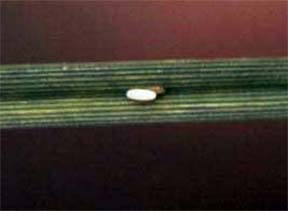
Photo 1. Egg of Syrphid fly on grasses. Photo credit: Whitney Cranshaw, Colorado State University.
We are conducting samplings in Allegan and Ottawa counties for early detection of the brown marmorated stink bug. No bugs have been found in blueberries, strawberries or raspberries.
On June 1, we had our last spotted wing Drosophila workshop. We had around 17 growers and consultants that spent time in classroom and hands-on sessions at the Trevor Nichols Research Center and in nearby farms where they learned how to scout for spotted wing Drosophila. Growers need to remain alert to detect the presence of spotted wing Drosophila in their fields. If you need assistance with monitoring, please call your local Extension office, or contact Carlos Garcia for assistance or information.
We would like to remind our blueberry growers about our Twilight Meeting series. A pair of post-bloom meetings begins on Thursday, June 9. The same meeting will repeat in Van Buren and Ottawa counties. The first meeting is June 9 from 5:00 to 8:00 PM at True Blue Farms, located south of Grand Junction. The second meeting is June 16 at A & L Farms, 11901 144th Avenue, West Olive, located a half-mile north of M-45.
The blueberry IPM meetings scheduled in Van Buren and Ottawa counties feature MSU Department of Plant Pathology’s Annemiek Schilder and MSU Department of Entomology’s Rufus Isaacs. Schilder will focus on disease control after bloom and through harvest, including mid-season disease control, fruit rots, canker diseases and virus diseases, as well as effective fungicide use. Isaacs talk will focus on insect control, including fruitworms, blueberry maggot, an update on spotted wing Drosophila and effective insecticide use.
There is a $10 charge for these meetings that includes dinner and handout materials. Growers need to call the MSU Extension office in the county hosting the meeting they plan to attend, so that meal arrangements can be made. For the Van Buren County meeting at True Blue Farms, contact Mark Longstroth at the Van Buren County Extension office at 269-657-8213. For the Ottawa County meeting, contact Judy Hanson at 616-994-4548.
West Central Michigan – Mira Danilovich, Michigan State University Extension
|
Weather and crop development
You did not want to be the “weather man” this past week. The weather service was revising their predictions often and, at the end, nature had it its way. The weather forecast was way off – high temperatures were predicted to be in the 60s with possible rain and yet, they climbed up well into the 80s with not even a cloud across the sky. Evapotranspiration is getting high and no rains to replenish the lost soil moisture. The soil is getting dry. Except for Bear Lake area, we have not seen any precipitation for a week. This afternoon (June 7) we had some dark clouds gathering over the Lake, but it seems that they dissipated as they reached the shoreline.
Tree fruit
Fruit is developing nicely. The apples are at the stage suitable for thinning (10 to 15 mm). Many area growers took advantage of the great thinning weather conditions over the weekend to apply thinners on apples. The carbohydrate model on theEnviro-weather website is showing that the apple fruitlets are coming out of the stressful situation they were in Saturday (June 4) and Sunday, and as of June 6, they are showing positive carbohydrate balance, making them less prone to thinning.
Sweet cherries are light and most estimates come to about 50 percent of the potential. Tart cherry crop is variable. Some blocks are very spotty with a less than average crop, and blocks where there is a very good crop. On the average, early yield estimates call for 75 percent of the full crop.
West Central Michigan Growing Degree Day Totals Since March 1 as of Sunday, June 5
| Location | DD42 | DD45 | DD50 | Rainfall | |
| Last Week | Since 4/1 | ||||
| Hart | 729 | 587 | 394 | 0 | 5.93 |
| Ludington | 694 | 556 | 371 | 0 | 7.24 |
| Bear Lake | 718 | 581 | 393 | 0.75 | 8.27 |
Insects
Insect activity has been on the rise. Oriental fruit moth numbers have gone down slightly since last week, averaging at 2.5. Redbanded leafroller numbers have gone down from 22.5 per trap to six. American plum borer numbers have exploded from 19 per trap to 40 in Mason County and 56 per trap in Oceana County. Lesser peachtree borers are showing strong flight with the average trap catch of seven moths. Pear psylla instars are visible in pear blocks. Plum curculio numbers have dropped down for 50 percent, averaging one per trap. Scouts are reporting finding various sizes of obliquebanded leafroller larvae in apples and cherries. Moderate pressure of rosy apple aphids and green apple aphids throughout the area. Black cherry aphids are starting to appear in a few blocks. White apple leafhopper nymphs are visible throughout the area.
All these jet streams from the south brought us some potato leafhoppers. They can become quite a problem in sensitive species like chestnuts. There is a lot of young, tender foliage that the leafhoppers are ready to attack.
Codling moth flight is very strong. There has been a significant jump in trap catches compared to last week. Scouts are finding great variability in the trap catches that necessitated localized, site-specific biofixing. The average trap count for Oceana County was 5.9 and the average trap count for Mason County was 6.7. For Oceana County, regional biofix was set for May 29 at 273 DD Base 50. Since then, we have accumulated 151 DD50 as of today. Regional biofix for Mason County was set for May 30 at 280 DD50. As of this evening, there is accumulation of 109 DD50 since biofix. Our options for treatment are Assail, Calypso, Clutch (Neonicotinoids) and Intrepid (IGR), given the spectrum of their activity could go on from 150-200 DD50. Guthion, Imidan (Organophosphates), Asana, Warrior, Danitol, Decis, Baythroid (Pyrethroids), Proclame (Avermectin) and Garnulovirus (Biopesticide) are recommended for 250 DD50 post biofix-timing.
Diseases
This week, there were no new apple scab and cherry leaf spot infections throughout the area. Low levels of lesions from previous infections are visible in the apple and cherry blocks. For apple scab, we have been at 100 percent mature spores for a few days. All we need is a good rain or two to flash them all out. Symptoms of fire blight and powdery mildew are sporadically found throughout the area.
Northwest Michigan – Nikki Rothwell, Duke Elsner, and Erin Lizotte, Michigan State University Extension
|
Weather report
The weather in northwest Michigan has done a 180 in the past week – we have gone from cool and wet to warm and dry. Daytime temperatures have been climbing into the mid-80s and the forecast is predicted to hit over 90 degrees today (June 7). With the warm temperatures, we accumulated quite a few growing degree days in the past week. As of this morning, we have accumulated 671GDD base 42 and 347GDD base 50. Conditions have also been on the dry side this past week. The much anticipated storm of last week did not bring the hail they predicted, but we did have high winds in the region. On May 31, we had 0.18 inches of rainfall and another 0.09 inches on June 3. However, rainfall has been variable throughout the region and some farms reported far more rainfall than we received at the NWMHRS.
Crop report
With the weather’s warm up, cherries are coming out of the shuck and we are able to better estimate the season’s crop. There are less sweet cherries than we originally thought and some varieties are light while others seem to have set a decent size crop. We hypothesize that the lighter than anticipated fruit set is due to poor pollination weather during bloom. The story is a similar one for tart cherries – the crop is not the limb breaker that was predicted two weeks ago. Variability among orchards is relatively high, but the most noticeable pattern is the variability throughout an orchard. Some trees have a large crop while others are extremely light. Tarts are just starting to come out of the shuck, and in the next few weeks, we will have a better idea of the crop load.
Bloom is still hanging on in many later blooming apple blocks throughout the region. However, most blocks are at or approaching petal fall and the fruit is starting to size. Apple pollination is somewhat in question and growers are eager to determine their crop load as most will be thinning this week. Our carbohydrate model is predicting normal thinning conditions and temperatures will be warm, and most thinners will go on this week. Growers have been in the orchard quite a bit for all tree fruits, either covering for diseases or gearing up for insect control – there has been no shortage of challenging weather thus far this season.
Strawberries are in bloom, and the pollination window is looking good for bee activity.
Pest report
Apples. Due to the dry weather, the apple scab model remained quiet over the past week. According to the apple scab model, 90 percent of overwintering spores have matured and 51 percent have discharged – this reflects no change in status from last week. We have seen symptoms of scab infection in high pressure and unmanaged orchards at this time. Primary scab infections develop first on spur leaves and the calyx end of the apple. Secondary spores called conidia are produced in the velvety-brown to olive colored lesions currently visible on leaves. The conidia serve as the source of secondary infections and are spread by wind and rain. A preventative scab program is critical. As we move into warmer weather and the risk of fruit scab increases as apples develop, growers should be considering second generation sterol inhibitor, such as Indar and Inspire Super, or Captan tank-mixed with EBDCs.
As many orchards still contain some bloom, the potential for blossom blight continues and keeping an eye on the weather and the fire blight model remains important. When the epiphytic infection potential (EIP) reaches 100 (or is forecast to do so) and the average temperature is greater than or equal to 60°F, the Enviro-weather model will show the corresponding boxes on the chart turning red, which indicates that if rain or trauma (high winds or hail) occur, there is a high potential for infection. Based on the weather forecast, the EIP will be extremely high in the coming days with forecasts predicting EIP levels over 300. At this time, streptomycin remains the bactericide of choice for controlling fire blight in the northwest. However, if you are located in Grand Traverse County and have streptomycin resistance, Kasumin may be applied during bloom. See MSU Department of Plant Pathology’s George Sundin’s article, Section 18 Special Exemption Label for Kasumin for Fire Blight Control In 2011, for more information on Kasumin use.
The next most important fire blight control measure is to use Apogee (prohexadione calcium) for shoot blight management. Apogee is a growth inhibitor that provides excellent control of shoot blight. The first timing for an Apogee spray is at king bloom petal fall. Apogee is shoot-specific, meaning the effect is only observed if the shoot is covered, thus excellent coverage is essential. The “Apogee effect” on fire blight begins approximately 10 to 14 days after application, and research from Sundin’s lab suggests that it is associated with cell wall thickening in apple shoots. It looks like cooler weather going into the weekend will finally cause the EIP to drop below 100.
Spotted tentiform leafminer trap catches continued to drop this week with an average of 50 moths per trap. Oriental fruit moth adults were trapped at lower numbers this week with an average of four moths per trap. Codling moth activity continued for the third week in a row – based on trap catch data, we are setting the codling moth biofix at the NWMHRS as of May 31. Based on the Station’s biofix, codling moth management will begin in the coming 7 to 10 days, depending on insecticide mode of action and temperature. The majority of treatments target egg hatch, a predicted 250 DD50 after sustained catch. Growers looking to use the relatively new method of an ovicide followed by a delayed larvicide application should look to apply ovicidal materials around 100-150GDD following sustained catch. Growers can track their progression using the codling moth model. Keep in mind that codling moth resistance to Guthion is well documented and that moths resistant to Guthion will also be resistant to pyrethroids. Refer to the MSU Extension bulletin E-154 Fruit Management Guide and the codling moth model for more information on management.
Obliquebanded leafroller larvae continue to develop (1 inch in some locations) and are prevalent in area apple orchards. Widespread obliquebanded leafroller resistance to Guthion and pyrethroids exists in northwest Michigan, so growers should be applying non-organophosphate materials to control this insect this season. In apples, obliquebanded leafroller populations are likely kept low by lepidopteron materials commonly used to combat organophosphate-resistant codling moth. Adult obliquebanded leafroller moths are easily trapped with pheromone baited delta traps, and larvae are also relatively easy to locate due to their leaf rolling behavior. At this time of the year, look for larvae in the terminals and evidence such as frass and webbing.
Cherries. Obliquebanded leafroller activity continues, with larvae quickly increasing in size (1 inch this week). Targeting this overwintering generation is critical in cherry and should be controlled early when they are small and easier to kill. An insecticide should be applied if two or more larvae are observed per tree. The materials that target this life stage are Delegate, Belt, Altacor, Voliam flexi, Entrust and Bts. Growers in northwest Michigan should not expect organophosphates or pyrethroids to provide effective control because of insecticide resistance. Obliquebanded leafroller do not feed internally in fruit, but are problematic as contaminants in tanks at harvest. No adult flight has been observed.
Plum curculio activity is evident in area orchards with crescent-shaped egglaying scars easily visible on green fruit. The two to three weeks following shuck split are when peak activity typically occurs and is coinciding with the mild evening temperatures the region has been experiencing. If growers are utilizing insecticides other than the organophosphates (Guthion, Imidan), the traditional treatment timing is petal fall or shuck split, depending on the mode of action. Consult the insecticide label or Michigan Fruit Management Guide for more information on proper timing. Based on a full bloom biofix of May 21, we have accumulated 205 DD50 towards the 375 DD50 window for organophosphate application for plum curculio management. First generation American plum borer activity is waning, but lesser peach tree borer was caught in Station traps for the first time over the past week. Lesser peach tree borer produce one generation per season with treatment targeting adult flight.
The potential for epidemic levels of cherry leaf spot is a concern this season. Despite some relatively tame leaf spot weather and model predictions, symptoms are present in the orchard at this time. Cherry leaf spot overwinters in fallen leaves on the orchard floor and produces apothecia (sexual spore-bearing structures) in the spring. Following infection, acervuli (asexual spore-bearing structures) develop on the underside of the leaf and produce a visible mass of asexual spores called conidia (these are currently visible). Spores are dispersed from leaf to leaf by wind or rain and this secondary infection cycle can be repeated several times within a season, depending on conditions. In the past, when we have seen symptoms of cherry leaf spot this early in the year, it quickly rises to epidemic levels and causes premature defoliation and reduced fruit ripening. This year, the symptoms are throughout the tree canopy and we hypothesize that this infection is due to fungicide wash-off rather than coverage issues. Refer to the article Cherry leaf spot observed on June 1 for more information.
Cherry leaf spot is resistant to sterol inhibitor fungicides, like Indar, Elite, and Orbit, in all the major fruit producing areas of Michigan. Full covers of Bravo are recommended where cherry are still in shuck split. As orchards move into first cover, full covers of products that contain strobilurin fungicides, like Gem, Pristine, and Adament, are recommended as they provide excellent leaf spot and powdery mildew control. Remember to alternate the use of fungicide classes and tank-mix with broad spectrum fungicides during the season to manage against resistance development.
Spur death caused by European brown rot has been reported, particularly in Balatons, but also in Montmorency. Nothing can be done at this time for European brown rot. Bacterial canker symptoms on sweet cherry leaves are visible, particularly in areas with leaf damage caused by high winds. Unfortunately, no control options will work against bacterial canker at this time. Lastly, the early symptoms of powdery mildew are also becoming visible. Before the mildew fungus become visible, leaf margins cup indicating the presence of an infection. The fungus itself will likely become visible over the next week and is most often found on younger leaf tissue.
Grapes. A great deal of vine growth over the last warm week has brought shoot development a bit closer to normal for early June. Some vinifera cultivars have reached a foot of shoot growth and are reaching the first catch wires.
High winds on May 31 resulted in some tattered leaves and in some cases, leaf surfaces that have been abraded with blowing soil. The topsoil is now drying out pretty badly in some vineyards, calling for irrigation.
Powdery mildew has not yet been detected at the Northwest Station vineyard, even on unsprayed vines. Now is a critical time to look closely for the first signs of infection on leaves.
Potato leafhopper adults have been found in the area for the first time this week. No grape berry moth adults were trapped at the station during the last week. Very high numbers of adult June beetles have been reported from several sites in the area. For more information on June beetles in Michigan, refer to MSU Department of Entomology’s Dave Smitley’s article, New bark beetle pests in Michigan.
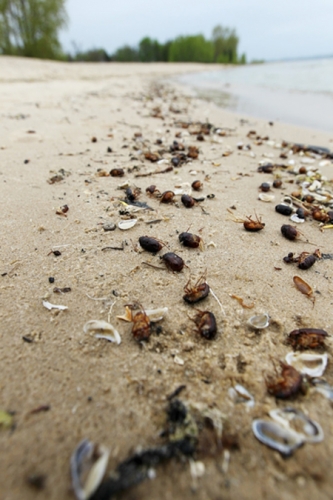
June beetles beached on the shore of Grand Traverse Bay in late May.



 Print
Print Email
Email